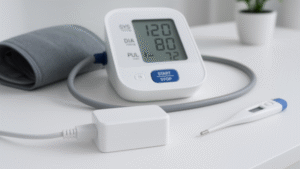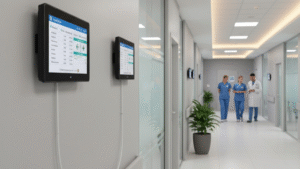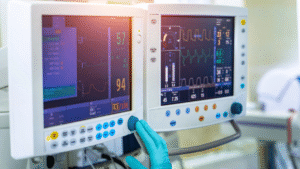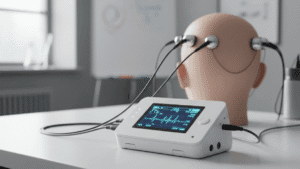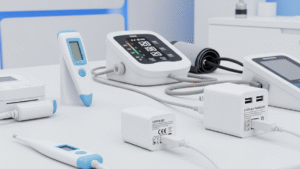In recent years, the design of medical and wellness equipment has undergone a quiet revolution, particularly in how devices are powered. One clear example of this trend is the growing adoption of external switch-mode power supply (SMPS) in enema machines.
What was once considered a niche medical or personal care device is now part of a broader trend toward efficiency, safety, and compact design. Power supply configuration, although rarely discussed, plays a critical role in ensuring these devices operate reliably and safely. This article will explore why more and more manufacturers of enema machines are choosing external SMPS over internal or linear power supplies.
Table of Contents
- Understanding Enema Machines
- What Is an External Switch-Mode Power Adapter?
- The Evolution of Power Supply Choices in Enema Devices
- Key Reasons Behind the Shift to External SMPS
- Engineering and Functional Benefits
- Challenges and Considerations
- Impact on Product Lifecycle and Supply Chain
- What to Consider When Selecting an External Power Adapter
- Future Trends in Enema Machine Power Design
- Conclusion
1. Understanding Enema Machines
Enema machines are devices designed to introduce liquid into the lower bowel for medical, cleansing, or detoxification purposes. They are used in hospitals, clinics, alternative wellness centers, and increasingly in home-care settings.
Basic components of an enema machine typically include:
- Water/fluid reservoir
- Flow control mechanisms
- Heating systems (for temperature regulation)
- Pumps or gravity-driven tubing
- Sensors for pressure and flow
- Digital control panel or interface
All of these components rely on a stable and safe power supply, making the power system a foundational part of the design.
2. What Is an External Switch-Mode Power Supply?
An external switch-mode power supply is a compact, energy-efficient device that converts AC power (from wall outlets) into low-voltage DC power suitable for electronic devices. Key characteristics include:
- High efficiency (typically 85% or higher)
- Lightweight and compact
- Built-in safety features
- Less heat generation compared to linear power supplies
- Capable of operating across wide voltage ranges (100–240V AC)
These attributes make external SMPS adapters particularly suitable for medical devices, including enema machines.
3. The Evolution of Power Supply Choices in Enema Devices
Traditionally, enema machines incorporated internal linear power supplies. These systems were simple but had significant limitations:
- Large and heavy transformers
- Inefficient energy conversion
- High heat generation
- Limited voltage tolerance
- Complex internal integration
As technology evolved, and user expectations around device design, portability, and reliability increased, linear power supplies started to fall short. That opened the door for switch-mode power supply technology, especially in external configurations.
4. Key Reasons Behind the Shift to External SMPS
4.1 Medical Safety Requirements
Safety is paramount in any medical or hygiene-related device. Regulatory standards such as IEC 60601-1 for medical electrical equipment require:
- Reinforced insulation
- Low leakage current
- Safe electrical isolation
- Protection against electric shock
External SMPS units designed for medical or wellness use typically meet these standards independently, allowing the enema machine itself to focus on functional design without bearing the full burden of power certification.

4.2 Thermal Management
Enema machines often feature heat-sensitive components like:
- Silicone tubing
- Flow valves
- Sensors
- Plastic housings
An internal power supply introduces additional thermal load, which can:
- Reduce the lifespan of nearby components
- Affects fluid temperature regulation
- Degrade seals or soft materials
By externalizing the power unit, heat is dissipated away from the machine body, reducing risk and improving durability.

4.3 Miniaturization and Portability
Today’s enema devices are expected to be:
- Lightweight
- Sleek in design
- Portable
- Aesthetically modern
Relocating the power supply externally allows for slimmer enclosures and more flexible mechanical layouts. For home users or mobile therapists, this is a strong selling point.
4.4 Maintenance and Replacement
Power failures are inevitable over time. With internal systems, repair often requires disassembling the device—an inconvenience and a safety hazard. In contrast:
- External adapters can be swapped quickly
- No special tools are needed
- Users can self-replace damaged adapters
- Downtime is minimized
This also extends the machine’s effective life.
4.5 Regulatory Simplicity
Each time a product is updated or localized for a different region, power supply compliance may require:
- Re-testing for EMC/EMI
- Surge and isolation analysis
- Thermal assessments
Using an external power adapter that is already tested and certified simplifies compliance efforts. Manufacturers benefit from faster time-to-market.
4.6 Global Voltage Compatibility
External adapters can be manufactured with universal input (100–240V AC), allowing the same model to be shipped globally with minimal changes. With regional plug changes, a single model can serve:
- North America
- Europe
- Asia-Pacific
- Middle East
This supports easier international distribution.

4.7 Design Cost Reduction
Designing a custom internal power supply involves:
- Electrical engineering design
- PCB layout
- EMI shielding
- Thermal simulations
- Regulatory testing
By selecting a qualified external power adapter, manufacturers can reduce engineering overhead, focus on product innovation, and lower per-unit costs.
4.8 EMI Reduction and Functional Reliability
Switch-mode power supplies generate electromagnetic noise. When housed inside a compact device, this can interfere with:
- Flow sensors
- Touch panels
- Wireless modules (Bluetooth, Wi-Fi)
External power adapters isolate switching noise away from sensitive components, enhancing overall signal stability and device accuracy.
5. Engineering and Functional Benefits
The engineering advantages of using external SMPS adapters include:
- Modular design for faster prototyping
- Simplified wiring architecture
- More flexible enclosure materials (no need for metal shielding)
- Easier integration with IoT or smart systems
- Support for multiple voltage rails via adapter selection
This enables scalable product development across entry-level and premium models.
6. Challenges and Considerations
Of course, the use of external adapters is not without challenges:
- Cable management: Long power cords can tangle or clutter user environments.
- Theft/loss risk: In public or shared settings, adapters may be misplaced or swapped.
- User error: Plugging in the wrong adapter (wrong voltage or polarity) may damage the device.
- Environmental durability: External units may be exposed to moisture or dust if not properly designed.
Design teams must factor these into their mechanical, labeling, and training strategies.
7. Impact on Product Lifecycle and Supply Chain
Externalizing the power supply reshapes the supply chain:
- Fewer SKUs required for machines (adapter varies by region)
- Easier inventory management
- Faster repair and service processes
- Potential to offer adapters as aftermarket parts or accessories
It also improves customer satisfaction by enabling self-service of minor faults.
8. What to Consider When Selecting an External Power Adapter

When choosing an adapter for an enema machine, manufacturers should assess:
- Output voltage and current (e.g., 12V/2A, 24V/3A)
- Plug type and polarity
- Medical vs. industrial certification level
- Protection features (over-voltage, short circuit, thermal)
- MTBF (Mean Time Between Failures) rating
- Physical size and casing material
- Energy efficiency rating
Adapters with low leakage current and reinforced insulation are particularly critical in hygiene-related applications.
9. Future Trends in Enema Machine Power Design
As enema machines evolve toward more intelligent and connected systems, power delivery will also adapt. Emerging trends include:
- USB-C Power Delivery integration
- Wireless charging platforms for tabletop units
- Battery-powered portable models
- Smart adapters with built-in diagnostics
The need for flexible, scalable, and safe power solutions will continue driving innovation in adapter design.
10. Conclusion
The move toward external switch-mode power adapters in enema machines is driven by a convergence of safety requirements, efficiency goals, engineering advantages, and evolving user expectations. External SMPS adapters offer:
- Improved thermal management
- Regulatory simplification
- Greater design flexibility
- Enhanced usability and maintenance
As enema machines become smarter, smaller, and more globally distributed, external adapters provide a practical and future-ready solution to meet power delivery needs.
For manufacturers and designers aiming to stay competitive and compliant, understanding and implementing high-quality external power supply solutions is no longer optional—it’s a strategic necessity.


